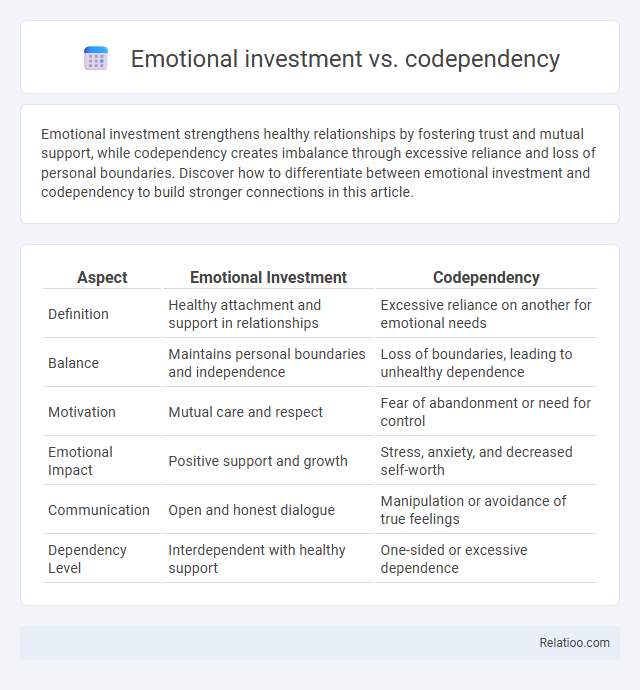Emotional investment strengthens healthy relationships by fostering trust and mutual support, while codependency creates imbalance through excessive reliance and loss of personal boundaries. Discover how to differentiate between emotional investment and codependency to build stronger connections in this article.
Table of Comparison
| Aspect | Emotional Investment | Codependency |
|---|---|---|
| Definition | Healthy attachment and support in relationships | Excessive reliance on another for emotional needs |
| Balance | Maintains personal boundaries and independence | Loss of boundaries, leading to unhealthy dependence |
| Motivation | Mutual care and respect | Fear of abandonment or need for control |
| Emotional Impact | Positive support and growth | Stress, anxiety, and decreased self-worth |
| Communication | Open and honest dialogue | Manipulation or avoidance of true feelings |
| Dependency Level | Interdependent with healthy support | One-sided or excessive dependence |
Understanding Emotional Investment
Emotional investment involves committing your feelings and energy to a relationship while maintaining personal boundaries, promoting healthy growth and mutual support. Unlike codependency, which entails excessive reliance on another person for emotional well-being and often leads to imbalance and loss of self-identity, emotional investment fosters independence and resilience. Understanding emotional investment helps you build stronger, more balanced connections that enhance your emotional health and personal development.
Defining Codependency in Relationships
Codependency in relationships involves an excessive emotional reliance on another person, often leading to a loss of personal identity and unhealthy boundaries. Unlike healthy emotional investment, which fosters mutual support and growth, codependency is marked by a compulsive need to meet the other's needs at the expense of your well-being. Understanding these distinctions is crucial for maintaining balanced, fulfilling connections.
Key Differences Between Emotional Investment and Codependency
Emotional investment involves a healthy attachment where individuals maintain boundaries and mutual respect, while codependency features an excessive reliance on another person's approval and validation, often leading to loss of self-identity. Key differences include emotional investment promoting balanced support and growth, whereas codependency fosters enabling behaviors and imbalance of power. Understanding these distinctions helps identify when a relationship enhances well-being versus when it becomes emotionally detrimental.
Healthy Emotional Bonds: What They Look Like
Healthy emotional bonds are characterized by mutual respect, trust, and support, enabling both partners to maintain their individuality while growing together. Unlike codependency, where one person sacrifices their needs to meet another's, healthy emotional investment fosters balanced interdependence without losing personal boundaries. Your relationship thrives when emotional connection encourages personal growth, open communication, and shared commitment without dependency or emotional exhaustion.
Warning Signs of Codependent Behavior
Warning signs of codependent behavior include excessive people-pleasing, difficulty setting boundaries, and an overwhelming need to control others' feelings or actions. Emotional investment becomes unhealthy when it leads to neglecting one's own needs, resulting in feelings of resentment, anxiety, or loss of identity. Recognizing patterns such as sacrificing personal well-being for others and seeking validation through caregiving is crucial to differentiate between healthy emotional investment and codependency.
Emotional Boundaries: Setting Limits for Well-being
Emotional investment involves healthy engagement with others while maintaining personal boundaries to protect well-being, whereas codependency often blurs these limits, leading to excessive reliance on another person's emotions. Setting clear emotional boundaries is essential to differentiate between supportive involvement and unhealthy attachment, promoting mental health and autonomy. Establishing these limits helps individuals nurture relationships without sacrificing their own emotional stability.
Impact of Emotional Investment on Personal Growth
Emotional investment fosters personal growth by encouraging self-awareness, resilience, and deeper connections without diminishing individual boundaries. In contrast, codependency often undermines growth by creating unhealthy reliance and emotional enmeshment that stifles autonomy. Healthy emotional investment enhances emotional intelligence and promotes balanced relationships essential for psychological development.
Consequences of Codependency in Relationships
Codependency in relationships often leads to unhealthy emotional dependence where Your sense of self-worth becomes tied exclusively to the other person, causing emotional imbalance and loss of personal boundaries. Unlike healthy emotional investment, codependency fosters enabling behaviors and suppresses individual needs, resulting in chronic stress, anxiety, and diminished self-esteem. Long-term consequences include emotional exhaustion, resentment, and difficulty establishing independent, fulfilling connections.
Steps to Foster Healthy Emotional Connections
Fostering healthy emotional connections requires clear boundaries to distinguish emotional investment from codependency, ensuring mutual support without losing individuality. Building open communication, practicing self-awareness, and maintaining independence promote balanced relationships that nurture growth and trust. Prioritizing emotional resilience and setting realistic expectations prevent unhealthy attachments while deepening authentic emotional bonds.
Seeking Support: Overcoming Codependency
Seeking support is crucial for overcoming codependency by fostering healthy emotional investment in relationships rather than reliance on others for self-worth. Professional therapy or support groups can help individuals develop boundaries and self-awareness, promoting balanced emotional connections. Practicing self-care and mutual respect replaces codependent behaviors with empowering, autonomous interactions.

Infographic: Emotional investment vs Codependency
 relatioo.com
relatioo.com